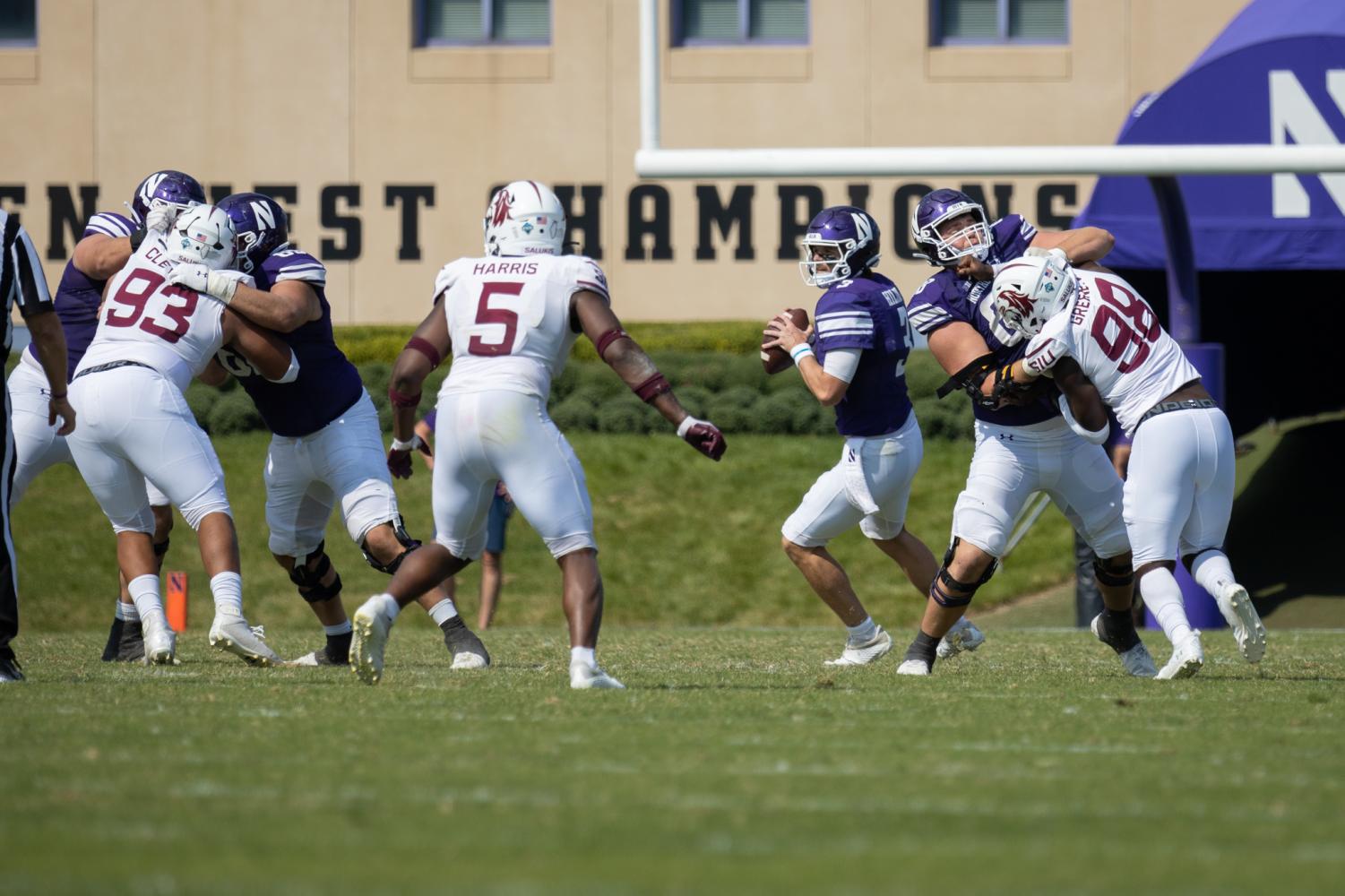Football: ‘It’s definitely something you learn as you go’: Wildcats detail their approaches to social media amid rough season
November 10, 2022
This fall, Ryan Hilinski’s life as a quarterback for the Wildcats and his role as a Northwestern student intersected in an unlikely but salient place — social media.
One of Hilinski’s classes is COMM_ST 227: Communication & Technology, a lecture class in the Communication Studies department that explores the impact modern technologies can have on mental health and overall well-being. The discussion on the harmful aspects of social networks, such as body image and negativity, caught the junior’s attention.
As NU’s starting quarterback for the beginning of the 2022 season and a starter in previous seasons for the Cats and South Carolina Gamecocks, Hilinski has been a fixture in the spotlight, on the field and online. His social media presence reflects that — he has more than 25,000 followers on Twitter and more than 47,000 on Instagram.
Hilinski’s social media presence is a prime example of the duality college athletes face in using social media. The California native has used his accounts to promote brands such as Degree and Portillo’s through Name, Image and Likeness, and utilizes Twitter and Instagram to engage with fans and commend his teammates. But with NU (1-8, 1-5 Big Ten) in the midst of a turbulent 2022 season and Hilinski shifting out of the starting lineup, social media platforms haven’t been a hospitable place for the Cats.
With today’s college football landscape making social media a near necessity, Hilinski said he approaches social media with intentionality — making the most of the platforms’ unique opportunities, while tuning out the crowd noise.
“With social media and athletes, if we use it the right way it can definitely be positive, but when you start reading the comments you start reading all of the comments and the bad stuff people have to say about you, it can be harmful,” Hilinski said. “If you have a good crew around you like we do at Northwestern, it can be very positive.”
From Hilinski and his teammates to coach Pat Fitzgerald, NU knows social media can easily become a distraction.
In the Cats’ run to the Big Ten Championship in 2020, NU football’s social media accounts recorded some of the highest growth rates in the nation as fans could publicly celebrate their team’s romp through the Big Ten West. But with NU in the rut of an eight-game losing streak this season, discourse has taken on a much more negative — and at times, toxic — tone, from users second-guessing decisions to calling for new faces at coordinator positions.
“There’s very little fact, there’s a lot of opinion on social media,” Fitzgerald said. “You’ve got to be able to decipher that and be mature, and not ride the roller coaster when things are great of being too high and when things are challenging of being too low.”
Hilinski said he deletes social media apps during the season, while graduate running back and captain Andrew Clair follows the social media advice Fitzgerald gave the team — paying attention to coaches and teammates rather than Twitter opinions.
“For us not performing to our capabilities, fans have a right, media has the right, everyone has a right to voice their opinion,” Clair said. “A lot of times, they don’t really know what’s going on behind doors, behind the scenes and people are just speaking from surface things they see.”
Still, both athletes see moderation as the best way to build a personal brand on social media.
Happy I got to meet y’all! Hope all is well and we get to see you again soon! #GoCats 💜 https://t.co/BbjJlMORkY
— Ryan Hilinski (@ryan_hilinski) September 8, 2022
In addition to his posts promoting NIL partners, Hilinski has used his accounts to highlight his family’s foundation, Hilinski’s Hope, which aims to destigmatize the conversation around mental health and support student athletes. Social media platforms have also provided players the opportunity to draw attention to their teammates’ accomplishments and identify with NU’s brand. When converted defensive lineman Duke Olges came on the field as a tight end and hauled in a touchdown against Iowa, the Cats’ players immortalized the clip on their Instagram stories.
“It does take a lot of responsibility, especially as a college player and depending on where you are, it can be a lot and take a toll on you,” Clair said. “Just knowing the ins and outs of who you are, what your brand is, what you’re trying to do and accomplish, social media can be very beneficial.”
Social media — and college football itself — does not look the same as it did when Hilinski and Clair started their college careers. Illinois did not adopt NIL legislation until June 2021, and since then NIL has revolutionized personal branding in a college athletics context. The rapid pace of change has raised the stakes further, and the line between promoting a personal brand and becoming a distraction has thinned.
Hilinski said his approach to social media has shifted over his four years in college football. His goal now is to prioritize the results on the field above all else.
“Social media is great in building your brand and all of that stuff, but when that becomes more important than the other stuff in your life, then you need to make a change,” Hilinski said. “I’ve seen that with a couple guys and talked with them about it, but it’s definitely something you learn as you go.”
Email: [email protected]
Twitter: @jhnriker

